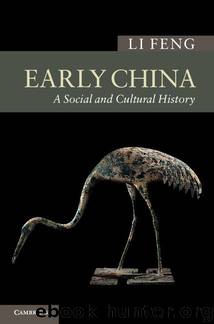Early China by Li Feng

Author:Li Feng [Feng, Li]
Language: eng
Format: epub
ISBN: 9780521895521
Publisher: Cambridge University Press
Published: 2013-11-30T00:00:00+00:00
Ethnic Relations and the Rise of the Huaxia Concept
The Spring and Autumn period was also a time during which the way the people in North China viewed themselves had been dramatically transformed by ongoing social and political changes. And this transformation is not unrelated to what was going on beyond the Zhou world. In fact, the Zhou dynasty down to the beginning of the fifth century BC paralleled in time the transition to pastoral nomadism that was taking place first in Central Asia and gradually spreading to Eastern Europe and East Asia. The collapse of the Western Zhou and the subsequent relocation of the Zhou royal court from the Wei River plain to Luoyang in the east had triggered waves of migration of the Rong (meaning warlike) peoples from the northwestern highlands into the central areas of the former Western Zhou. A number of such Rong groups were recorded to have occupied locations close to the confluence of the Yellow River and Wei River in eastern Shaanxi; some of these groups might have moved as far as western Henan near the royal capital in Luoyang (Map 8.1 above). In the north and northeast, groups identified as the Di people had moved down along the Taihang Mountain ranges and founded many small polities such as Wuzhong and Xianyu in Hebei and northern Henan after wiping the Zhou states Xing and Wey off the map. Some of the tribesmen, for instance, the Long Di people, who were probably very tall, might have occupied places in eastern Henan and western Shandong in the late seventh century BC.22 Towards the end of the seventh century BC, even those states in the core area of the Zhou realm had come to find Rong and Di communities in their neighborhood; states on the periphery such as Qin and Jin were traditionally known to have been always surrounded by the various Rong people.
The relationship between these Rong or Di polities and the indigenous Zhou states was complicated to say the least. War was not the unvarying form of relationship between them – occasionally we find that certain Rong or Di groups were on campaigns along with their Zhou partners against other Zhou states. During the turmoil in the royal court caused by Prince Chao, the Rong people were among the troops from Jin that restored the Zhou king to the throne in 520 BC. A century earlier, another pretender to the royal throne, Prince Dai, employed the troops of Di to attack the Zhou capital and drove King Xiang out of the royal capital. There were also Rong or Di polities that carried out successful diplomacy, mediating between the Zhou states. Despite the regular contact between the Rong or Di polities and the indigenous Zhou states, the ethnic and cultural distinction remained clear to both sides, and this is illustrated by the experience of a group of the Rong people identified as “Jiangshi.” In the words of their chief transmitted in the Zuo Commentary, this Rong group was originally located in the far west.
Download
This site does not store any files on its server. We only index and link to content provided by other sites. Please contact the content providers to delete copyright contents if any and email us, we'll remove relevant links or contents immediately.
| Africa | Americas |
| Arctic & Antarctica | Asia |
| Australia & Oceania | Europe |
| Middle East | Russia |
| United States | World |
| Ancient Civilizations | Military |
| Historical Study & Educational Resources |
The Sympathizer by Viet Thanh Nguyen(4284)
The Rape of Nanking by Iris Chang(4120)
World without end by Ken Follett(3411)
Ants Among Elephants by Sujatha Gidla(3391)
Blood and Sand by Alex Von Tunzelmann(3114)
Japanese Design by Patricia J. Graham(3089)
City of Djinns: a year in Delhi by William Dalrymple(2493)
The Queen of Nothing by Holly Black(2461)
Foreign Devils on the Silk Road: The Search for the Lost Treasures of Central Asia by Peter Hopkirk(2418)
India's Ancient Past by R.S. Sharma(2394)
Inglorious Empire by Shashi Tharoor(2383)
Tokyo by Rob Goss(2368)
In Order to Live: A North Korean Girl's Journey to Freedom by Yeonmi Park(2325)
Tokyo Geek's Guide: Manga, Anime, Gaming, Cosplay, Toys, Idols & More - The Ultimate Guide to Japan's Otaku Culture by Simone Gianni(2301)
India's biggest cover-up by Dhar Anuj(2299)
The Great Game: On Secret Service in High Asia by Peter Hopkirk(2286)
Goodbye Madame Butterfly(2188)
Batik by Rudolf Smend(2094)
Living Silence in Burma by Christina Fink(2023)
